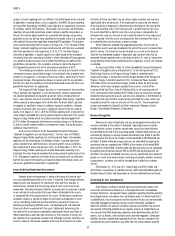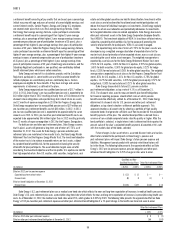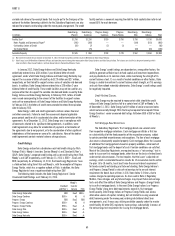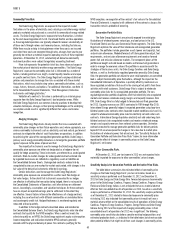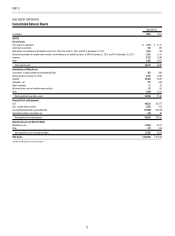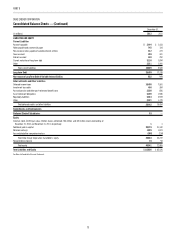Duke Energy 2012 Annual Report Download - page 83
Download and view the complete annual report
Please find page 83 of the 2012 Duke Energy annual report below. You can navigate through the pages in the report by either clicking on the pages listed below, or by using the keyword search tool below to find specific information within the annual report.
63
PART II
Commodity Price Risk
The Duke Energy Registrants are exposed to the impact of market
fl uctuations in the prices of electricity, coal, natural gas and other energy-related
products marketed and purchased as a result of its ownership of energy related
assets. The Duke Energy Registrants’ exposure to these fl uctuations is limited
by the cost-based regulation of its U.S. Franchised Electric and Gas operations
as these regulated operations are typically allowed to recover substantially all
of these costs through various cost-recovery clauses, including fuel clauses.
While there may be a delay in timing between when these costs are incurred
and when these costs are recovered through rates, changes from year to year
generally do not have a material impact on operating results of these regulated
operations. At December 31, 2012, substantially all derivative commodity
instrument positions were subject to regulatory accounting treatment.
Price risk represents the potential risk of loss from adverse changes in
the market price of electricity or other energy commodities. The Duke Energy
Registrants’ exposure to commodity price risk is infl uenced by a number of
factors, including contract size, length, market liquidity, location and unique
or specifi c contract terms. The Duke Energy Registrants employ established
policies and procedures to manage the risks associated with these market
fl uctuations, which may include using various commodity derivatives, such as
swaps, futures, forwards and options. For additional information, see Note 15
to the Consolidated Financial Statements, “Risk Management, Derivative
Instruments and Hedging Activities.”
Validation of a contract’s fair value is performed by an internal group
separate from the Duke Energy Registrants’ deal origination areas. While
the Duke Energy Registrants use common industry practices to develop their
valuation techniques, changes in their pricing methodologies or the underlying
assumptions could result in signifi cantly different fair values and income
recognition.
Hedging Strategies.
The Duke Energy Registrants closely monitor the risks associated with
commodity price changes on their future operations and, where appropriate, use
various commodity instruments such as electricity, coal and natural gas forward
contracts to mitigate the effect of such fl uctuations on operations, in addition
to optimizing the value of the non regulated generation portfolio. Duke Energy’s
primary use of energy commodity derivatives is to hedge the generation portfolio
against exposure to the prices of power and fuel.
The majority of instruments used to manage the Duke Energy Registrants’
commodity price exposure are either not designated as a hedge or do not
qualify for hedge accounting. These instruments are referred to as undesignated
contracts. Mark-to-market changes for undesignated contracts entered into
by regulated businesses are refl ected as regulatory assets or liabilities on
the Consolidated Balance Sheets. Undesignated contracts entered into by
unregulated businesses are marked-to-market each period, with changes in the
fair value of the derivative instruments refl ected in earnings.
Certain derivatives used to manage the Duke Energy Registrants’
commodity price exposure are accounted for as either cash fl ow hedges or
fair value hedges. To the extent that instruments accounted for as hedges
are effective in offsetting the transaction being hedged, there is no impact to
the Consolidated Statements of Operations until after delivery or settlement
occurs. Accordingly, assumptions and valuation techniques for these contracts
have no impact on reported earnings prior to settlement to the extent they
are effective. Several factors infl uence the effectiveness of a hedge contract,
including the use of contracts with different commodities or unmatched terms
and counterparty credit risk. Hedge effectiveness is monitored regularly and
measured at least quarterly.
In addition to the hedge contracts described above and recorded on
the Consolidated Balance Sheets, the Duke Energy Registrants enter into other
contracts that qualify for the NPNS exception. When a contract meets the
criteria to qualify as an NPNS, the Duke Energy registrants apply such exception.
Income recognition and realization related to NPNS contracts generally
coincide with the physical delivery of power. For contracts qualifying for the
NPNS exception, no recognition of the contract’s fair value in the Consolidated
Financial Statements is required until settlement of the contract as long as the
transaction remains probable of occurring.
Generation Portfolio Risks.
The Duke Energy Registrants are primarily exposed to market price
fl uctuations of wholesale power, natural gas, and coal prices in the U.S.
Franchised Electric and Gas and Commercial Power segments. The Duke Energy
Registrants optimize the value of their wholesale and non regulated generation
portfolios. The portfolios include generation assets (power and capacity), fuel,
and emission allowances. Modeled forecasts of future generation output, fuel
requirements, and emission allowance requirements are based on forward
power, fuel and emission allowance markets. The component pieces of the
portfolio are bought and sold based on models and forecasts of generation in
order to manage the economic value of the portfolio in accordance with the
strategies of the business units. For Duke Energy Carolinas and Duke Energy
Indiana, as well as the Kentucky regulated generation owned by Duke Energy
Ohio, the generation portfolio not utilized to serve retail operations or committed
load is subject to commodity price fl uctuations, although the impact on the
Consolidated Statements of Operations is partially offset by mechanisms in
these regulated jurisdictions that result in the sharing of net profi ts from these
activities with retail customers. Duke Energy Ohio is subject to wholesale
commodity price risks for its non regulated generation portfolio. The non-
regulated generation portfolio dispatches all of their electricity into unregulated
markets and receives wholesale energy margins and capacity revenues from
PJM. Duke Energy Ohio has fully hedged its forecasted coal-fi red generation
for 2013. Capacity revenues are 100% contracted in PJM through May 2015.
International Energy generally hedges its expected generation using long-term
bilateral power sales contracts when favorable market conditions exist and it is
subject to wholesale commodity price risks for electricity not sold under such
contracts. International Energy dispatches electricity not sold under long-term
bilateral contracts into unregulated markets and receives wholesale energy
margins and capacity revenues from national system operators. Derivative
contracts executed to manage generation portfolio risks for delivery periods
beyond 2013 are also exposed to changes in fair value due to market price
fl uctuations of wholesale power, fuel oil and coal. See “Sensitivity Analysis for
Generation Portfolio and Derivative Price Risks” below, for more information
regarding the effect of changes in commodity prices on the Duke Energy
Registrants’ net income.
Other Commodity Risks.
At December 31, 2012, pre-tax income in 2013 was not expected to be
materially impacted for exposures to other commodities’ price changes.
Sensitivity Analysis for Generation Portfolio and Derivative Price Risks.
The table below summarizes the estimated effect of commodity price
changes on the Duke Energy Registrants’ pre-tax net income, based on a
sensitivity analysis performed as of December 31, 2012 and December 31,
2011 for Duke Energy and Duke Energy Ohio. Forecasted exposure to commodity
price risk for Duke Energy Carolinas, Progress Energy Carolinas, Progress Energy
Florida and Duke Energy Indiana is not anticipated to have a material adverse
effect on their consolidated results of operations in 2013, based on a sensitivity
analysis performed as of December 31, 2012. The sensitivity analysis performed
as of December 31, 2011 related to forecasted exposure to commodity price
risk during 2012 also indicated that commodity price risk would not have a
material adverse effect on the consolidated results of operations of Duke Energy
Carolinas, Progress Energy Carolinas, Progress Energy Florida and Duke Energy
Indiana during 2012 and the impacts of changing commodity prices in their
consolidated results of operations for 2012 was insignifi cant. The following
commodity price sensitivity calculations consider existing hedge positions and
estimated production levels, as indicated in the table below, but do not consider
other potential effects that might result from such changes in commodity prices.


